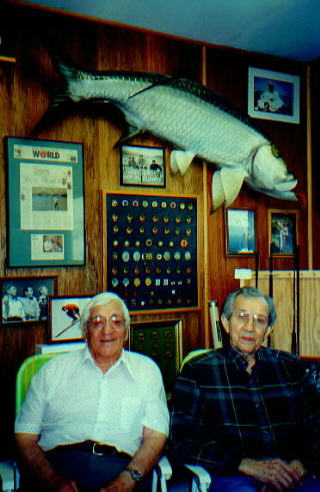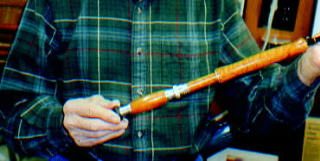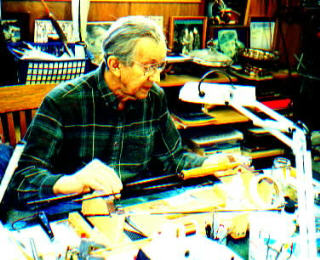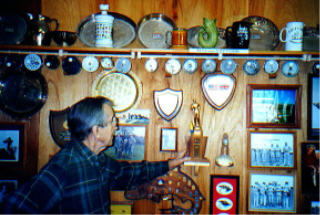Search
Latest Articles
A New Fly Casting System
by Dave Graybill, February 01, 2003
A New Fly Casting System
By Dave Graybill
Bill McGuire and Buzz Fiorini had each spent careers in the professional fishing and hunting industry that spanned over fifty years. They were both aware of each other’s reputations and accomplishments. They had attended the same outdoor shows and exhibitions at the same time and place over the years, but had never actually met face to face. That finally happened in March of 2000 in Rock Island, Washington, and the outcome was the launch of yet another enterprise by the two fly rod-and-line building experts. They combined their expertise to develop a new fly-casting system that allows novice and physically restricted casters to toss a line 60 to 90 feet with ease.
McGuire and Fiorini have spent their lives traveling the world demonstrating their superior abilities in trade shows or guiding celebrities and elite business people. That they would gravitate to this particular enterprise may seem a bit odd, until you know more about them.

Here is Buzz on the right and Bill McGuire in their shop
The passion for fishing still burns bright in both of these gentlemen, but the ability to really enjoy it at their advanced age caused them both some frustration. The sinew and bones just don’t respond the same way after 70 years of use. Fiorini was particularly crippled by a shoulder surgery that severely restricted the range of mobility of his casting arm. He wasn’t about to give up on his three trips a week to Rocky Ford Creek, so they set about finding a way to extend their active lives as anglers.
The result is a combination of rod design and line building, with a two-handed casting technique that brings maximum performance to the whole package. The two of them had me casting 60 or 70 feet (a mean feat with my casting ability) with just five minutes of coaching. This was without the butt extension that allows for the two handed method of casting. When Buzz added the extension, he threw the line 90 feet with a simple wrist snap motion. This conservation of motion with the resulting power is what they were seeking. Eureka!
The casting system is a combination of several elements, but the key is in the design of the shooting head and the splicing together of each piece. They start with a basic three- to-one ratio of line weight to rod specification. Using the formula for a five-weight rod, they build an eight-weight shooting head. According to Buzz, manufacturers suggest using a five-weight line on a five-weight rod not for ideal performance, but to avoid breakage from over-powering a rod blank with a heavier line. He should know something about this. He founded the Fenwick Fishing Rod Company in 1950, after spending time as a representative for Orivs.

Here is the extended handle
He knows that most anglers will get better casting performance by moving up a line weight or two, and with their system they go up three. Working backwards from the reel, here’s how they put together a line. The backing they put on a reel is usually 30-pound braided Dacron, with enough to fill the spool when fully loaded with the completed line. To this the backing they add another 50 feet of 30-pound braided running line. Next comes 30 feet of eight-weight shooting line. The shooting head is finished with two feet of 30-pound braided line, one foot of 20-pound braided line and then six feet of level monofilament leader.
The key to assembling this shooting head style line is the splicing. Buzz raves about his frustration of trying to get his needle through different types of braided line while Bill chuckles in the background. What Buzz finally found out was that if he boiled the line, he got rid of the wax that impregnated the line and it got a lot easier to inset his needle to do the splices. This may seem a small stumbling block, but when you review the number of splices required to assemble each shooting head, it adds up to a major breakthrough in the manufacture of each line.
They now had a line that would work like a shooting head, but with an interesting twist. The final section of the line, the two feet of 30-pound and one foot of 20-pound spliced ahead of the leader made this whole concoction perform as a complete fishing line. This final touch dissipated the power of the shooting head and allowed the leader to "float" down to the water. At the end of a 90-foot, power cast, a leader will still softly touch down. Buzz has been adding what he calls his special "power dissipating" device to his lines for fourteen years, and notes that just this year the new Cortland catalogue features a "power dissipating leader" on their Climax Wind line.
Okay. They got the line thing down. A casters dream. Now for the rod that would complete the package. Remember the rod has to be able to handle this special line with the added feature of the two handed extension handle to really make it "punch" out there. Not a problem.
Bill McGuire showed me a photograph of his custom-made rods debuting at a California retail store dated 1950, and he hasn’t stopped refining his rod building techniques. He’s kept up on the new materials and manufacturers and the demands of today’s fly fishing angler.
When it comes to building a fly rod Bill cuts no corners. He starts with a Sage blank, which he considers the best on the market. He constructs the rods in four pieces, confident that with the advances in technology of materials and his abilities that he can put together a four-piece that performs as well as a two-piece without question. Single foot titanium guides and titanium alloy reel seats, of course. Nothing but the best.

Here is Bill at the rod-building bench
Another important reason that the rods are made in four pieces is that they break down to a compact package when transported. They take up little space in your rig on your way to a local fishing spot, and also fit in the overhead of an airplane. Two-piece rods go with your baggage now, and often don’t show up on the carousel when you look for your luggage at the end of a flight.
The finished nine-foot rods that come out of this small shop in Rock Island are a beautiful rendition of the form and function of a fly rod, and cast as good as they look. When the small extension handle is added it’s like adding a magnum load to a cartridge.
Bang!
I mentioned earlier that Buzz can throw this line with the two handed technique with a flick of his wrists, and so can you. Because there’s another element of experience that has gone into the construction of the rod and line that can’t be seen in the final product, but it is a big part of the process. Bill McGuire has been winning national casting championships since the 40s. He has won casting awards at a national level for casting distance and accuracy, not only for dry fly, but wet fly and spin casting, too! One trophy has the three-eight’s ounce casting plug hanging from it that he threw 325 feet—with a single-handed spinning rod.
Bill knows casting.
Both Bill and Buzz know something about the performance of equipment in the field as well. They have both traveled the world fishing for freshwater and saltwater species. Buzz was the tour director for Boeing for twelve years. He chartered John Wayne’s yacht for two months each year, and with his float plane in tow would guide the likes of the heads of airline companies and such to Alaska’s great salmon and trout fisheries. There is even has a book in print about Buzz’s exploits titled Flying Over Rainbows, by Dwayne Parsons. An interesting note is that Buzz once won a tarpon tournament using a two-handed fly rod that he had brought along, and the next year they were banned!
Bill McGuire was doing a casting exhibition in England once, and was afforded an honor reserved only for royalty and the exceptionally distinguished. He got the chance to fish the "Queens Pool". This Atlantic salmon water is the exclusive haunt of Queen Mother and her special guests.
There are more stories like these about these two amazing people than my hard drive could hold, and that’s another advantage of those who purchase or want to try out their new casting system. They get to meet and get instruction from Bill and Buzz.

Bill looks at some of the trophies that fill the walls in the shop
You see they aren’t running a retail store. They’re just a couple of custom rod makers having a good time at it, as they say.
It’s obviously a labor of love. They way they price their product they aren’t trying to get rich. They offer the complete package of rod, line, and backing, handle extension, reel—even casting lessons for $460.00. A little research into the catalogues from major manufacturers of quality fly-fishing equipment reveals that the equivalent set up would cost almost $800.00!
No, these guys aren’t in it for the money. They just love putting these outfits together and putting them in the hands of people who can appreciate how they work.
Their combined efforts have not only found a way to extend the fishing life of Buzz, but anyone who has similar problems with restricted movement. It has also proven very popular with women. It gives them a real jump-start on casting, which can often frustrate beginners, no matter what gender. More than once they have sold an outfit to a women and have the husband come in a while later and buy one for themselves!
Another advantage to this quick-fire system of distance casting is that it eliminates false casting. Both Bill and Buzz agree that they have spooked too many fish over their lifetimes in the process of false casting to get the necessary line in the air.
If an angler would like to learn more about their casting system, they can call or write to Bill and Buzz at B & B Enterprise, 1240 Center Street, P.O. Box 375, Rock Island, WA 98850. The phone number at the shop is (509) 884-6021. They’d love to talk to you.
In fact that’s the best part of all. Talking to these two who have enjoyed a life of fishing that is astounding and how they have put together their shared experiences to make it easier for others to enjoy the sport.
Each of them has spent their working lives showing others how spectacular things can be done in the sport of fishing, either by demonstrating or guiding. Now they are relaxing, but together they have found yet another means in which to continue to contribute to the sport in which they have very special aptitudes.
What a way to live.



